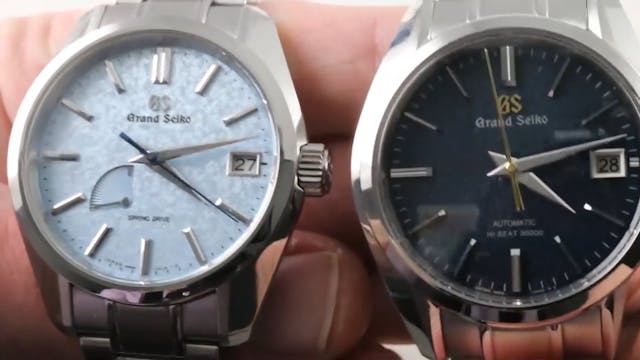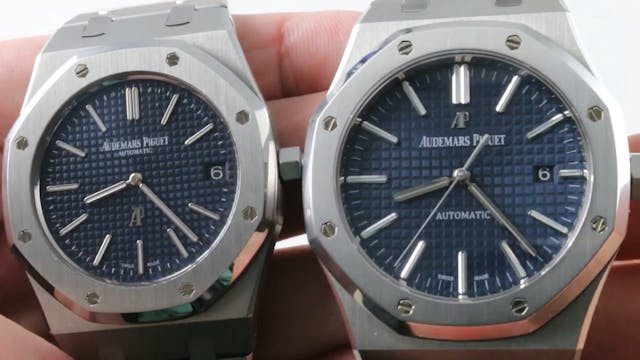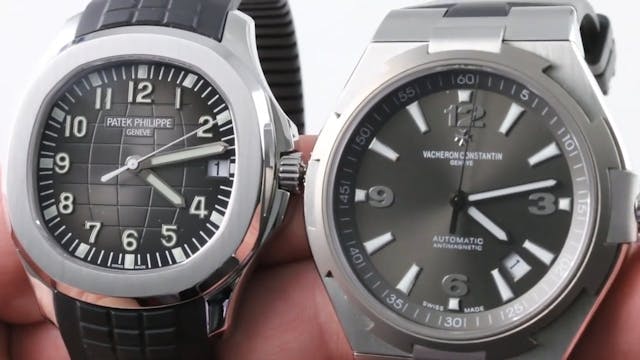Rolex GMT Master II Pepsi 126710BLRO vs. 2018 Tudor Black Bay GMT Pepsi 79830RB0
Versus
•
8m 35s
The Pepsi Challenge! Rolex vs Tudor Pepsi!
The Tudor Black Bay features a 41mm stainless steel case surrounding a black dial on a stainless steel bracelet. Features include hours, minutes, seconds, GMT, and date. The watch also measures 14.5mm in thickness and 50.2mm from lug-to-lug.
The Rolex GMT-Master II “Pepsi” features a 40mm stainless steel case surrounding a black dial with two-tone “Pepsi” Cerachrom bezel on a stainless steel Jubilee bracelet with a folding buckle. Functions include hours, minutes, seconds, date and GMT. The watch also measures 12.1mm in thickness and 48.1mm from lug-to-lug.
Shop Rolex: https://www.thewatchbox.com/watches/rolex/
Shop Tudor: https://www.thewatchbox.com/watches/tudor/
Okay, this is going to be kind of like a poor man's versus. I didn't want to continue the relentless drumbeat of Rolex in that series. So, I'm going to do a mini comparison between two of the hottest watches of 2018. May I present the Pepsi twins. On the left, the 2008 Tudor Black Bay GMT, which just happens to bear a striking resemblance to the 2018 Rolex GMT-Master II Pepsi 126710BLRO.
Okay, are all Pepsis created equal? Well, no, and there are obvious reasons for that. These two watches are distinct in their look and the experience of owning them. This can be a mini comparison. Full-length videos for both will be available separately on the channel, so be sure to check those out for a more comprehensive showcase in each instance.
Let's start with age before beauty. I kid—we're going to go with the Rolex first because the Rolex has the longer tradition in the house of Rolex. And the Geneva giant, of course, being all about its charter brand, Tudor, came along in 1946 and thus we go with the GMT first. OK, first things first. The Rolex GMT-Master II Pepsi is 40mm in diameter and stainless steel. From lug-to lug, it's 48.1mm and it's 12.1mm thick. On my 16cm circumference wrist, it plays the part of the dress watch—here is the Jubilee bracelet is distinctly more elegant with a more delicate proportioning and a lighter wrist feel than the Oyster style simulated rivet bracelet on the Tudor. Now, you'll also note that it is perhaps a little bit more elaborately finished, because not only is it a more delicate pattern of five links versus three, with smaller links versus larger, but this one features both polish and satin, whereas this one features entirely satin finish with the exception of the flanks and the rivet style profiling. Now, the clasps, I have to say, the Rolex features a more sophisticated clasp with its 5mm easy link. I actually have to say that the Tudor feels as though its clasp is more robust. Now you could see the Rolex, perhaps a more compact clasp profile—the Tudor, and I'm going to show you side by side right now, the Tudor, perhaps a little bit more like an older Rolex clasp executed with modern fit and finish—which is to say you have the clamshell profile, but then you have adjustment done by strap tool hole. So, those little strap tool apertures allow you to make your micro-adjustment. There's no easy link style quick link. You’ll also note that there are actually bump stops for the clamshell in ceramic for long wearing durability. That said, though, a little bit more primitive in its construction, the Tudor clasp does feel more solid and inspires more confidence.
Now, in terms of case profiling, you can see the Rolex GMT-Master II Pepsi being 12.1mm thick is a good deal thinner than 14.5mm of the Tudor. Just look at the profiles of those lugs and you get a sense of why the Rolex is better suited as a sartorial all around her. You'll also note that the Rolex does have a more delicate lug profile. It doesn't have those vintage evocative bevels that you find on the flank of the GMT Tudor. Now, I will note that the Tudor features pivoted end links rather than solid end links. So, it winds up being almost as narrow across the wrist as the Rolex—they’re only .5mm apart with the Rolex being 49.5mm and the Tudor effectively 50mm lug-to-lug.
Now in terms of the Tudor’s dial and bezel, you could be mistaken, or you could be forgiven, I should say, for mistaking this bezel for a Coke. The actual lighting here is such that you can just barely make out that it's a very dark navy blue. And it's also a difference of material as the Tudor uses a traditional anodized aluminum, and the Rolex uses a contemporary ceramic. Obviously, the Rolex bezel far more expensive to make, far more scratch-resistant. If it has any weakness at all, it's the fact that, of course, ceramic can chip and aluminum can only really scratch. That said, I will give a shout out to the norling on the edge of the Tudor bezel. You'll note that the norling on the edge of the Rolex is deeper and more traditional. It looks like a Rolex, but it's also harder to grip if your fingers are in any way sweaty, gloved or wet. Also important to note, the Tudor has a little bit of incoherence about its design as it doesn't quite know what era from which it hails. There's a combination of Chapter Ring, early 60s Tudor Sub, there's a little bit of 70s Snowflake, and there's a little bit of Rolex 1675 GMT in there as well, all at the same time. Whereas the Rolex GMT-Master II Pepsi has more coherence, and perhaps, a sounder sense of its own identity about its dial. Rolex with blue chromalight, the Tudor with a more conventional green LumiNova—there will be a double lume shot at the end of this video, of course.
Tudor, major points: no Cyclops eye. And guess what? I can still tell the date. Why bother Rolex? This is a official request from the universe of collectors. Give us a date without a cyclops. Just try it. Try it once. Another difference is that the Rolex dial base is glossy. It is like a lacquer. It has a gloss, a gleam, a glint and a reflective quality, almost like wet paint. Whereas the dial of the Tudor is not just a matte black, it's actually a pebbly, grained matte black. It has a little bit of a texture and a light rusticated, almost sandpaper-like surface. So, the Tudor is not just a matte finish versus gloss. The Tudor also is a different surfacing about its dial.
The Rolex GMT-Master II Pepsi features crown guards and a trip-lock crown. This is a trip-lock crown like you'd find on a Sub, despite the fact this is a 100m water-resistant watch. Big, burly, rounded guards, too—no joke here. If you look at the Tudor compared to the Rolex, first you'll note that the Tudor has two logos, a shield on the dial and the older pre 1968-rose on the crown. Also, no crown guards and a far larger Big Crown style crown. This one actually has 200m water-resistance compared to the Rolex 100m. Now for 2018, the GMT does adopt a 70-hour power reserve by virtue of caliber 3285. This is Tudor MT5652. 70-hour power reserve here, 70-hour power reserve here. The main difference? This one has a silicon hairspring, and if I want to be really picky, I could say the Tudor is more industrial in it's finish will Rolex though, you can't see it. It has been taking measures to more elaborately finish its movements—only your watchmaker will know. But, at least you'll know what you're paying for.
In every other respect, I have to say that the Tudor competes shockingly well against its older brother. I don't know which one's the big brother at this point because the Tudor is bigger, but the Rolex is older. They are both sensational. And, I'm going to do a quick wrist shot of each one, and then I'm going to quickly phase in a lume shot so you have the ability to judge one against the other when night falls. So, here's the Tudor, 41mm in diameter, no crown guards, 14.5mm thick. Lug-to-lug it is 50.2mm, and pivoted end links means it measures true lug-to-lug on the wrist. Okay, 16cm circumference wrist—that's what you get.
Now, back to the Rolex GMT-Master II Pepsi, a much lighter wrist feel—40mm case. Yes, it's a Super Case, but compared to the Tudor, it almost feels like an old school vintage Rolex. 12.1mm thick, 40mm in diameter, crown guards, 48.1mm lug-to-lug, 49.5mm when you include the end links of the bracelet.
Now, you've seen them both—you can go on the watchbox.com and decide which one gets your vote as the winner of the Cell Sweepstakes 2018.
And now we're back with the Black Bay GMT and the GMT-Master II. I have to say, Rolex chromalight is distinctive, but I feel like the Tudor is more distinct. I should also mention that the final distinction between them on a chronometric basis is that the Rolex is rated from the factory to -2/+2 for 24 hours. It's a superlative chronometer. That's Rolex’s timing standard and Rolex’s nomenclature. The Tudor is a COSC-certified chronometer, but that's promising only -4/+6 per 24 hours. So, on a pure chronometric basis, I bet they can be adjusted to run at the same rate, but Rolex will attest to greater. And, Rolex will give you a 5-year warranty versus the Tudor’s 2.
Up Next in Versus
-
Grand Seiko Spring Drive SBGA387 vs H...
The 2018 Grand Seiko Hi Beat 9S 20th Anniversary SBGH267 is a 1,500-piece limited edition celebrating 20 years since the launch of Grand Seiko's seminal 1998 9S mechanical luxury timepiece. Its blue "mosaic" dial, hi-beat automatic caliber, and versatile 39.5mm stainless steel case ensure that th...
-
Audemars Piguet Royal Oak 15202 Jumbo...
Audemars Piguet Royal Oak Jumbo vs Royal Oak 15400 is a family feud with eight sides five hands, and two watches. Today on Versus, stainless steel Audemars Piguet 15202 and 15400 Royal Oak automatics wage a generational war between the nearest descendent of Gerald Genta’s 1972 Royal Oak 5402 and ...
-
Vacheron Overseas 47040/000W-9500 vs ...



